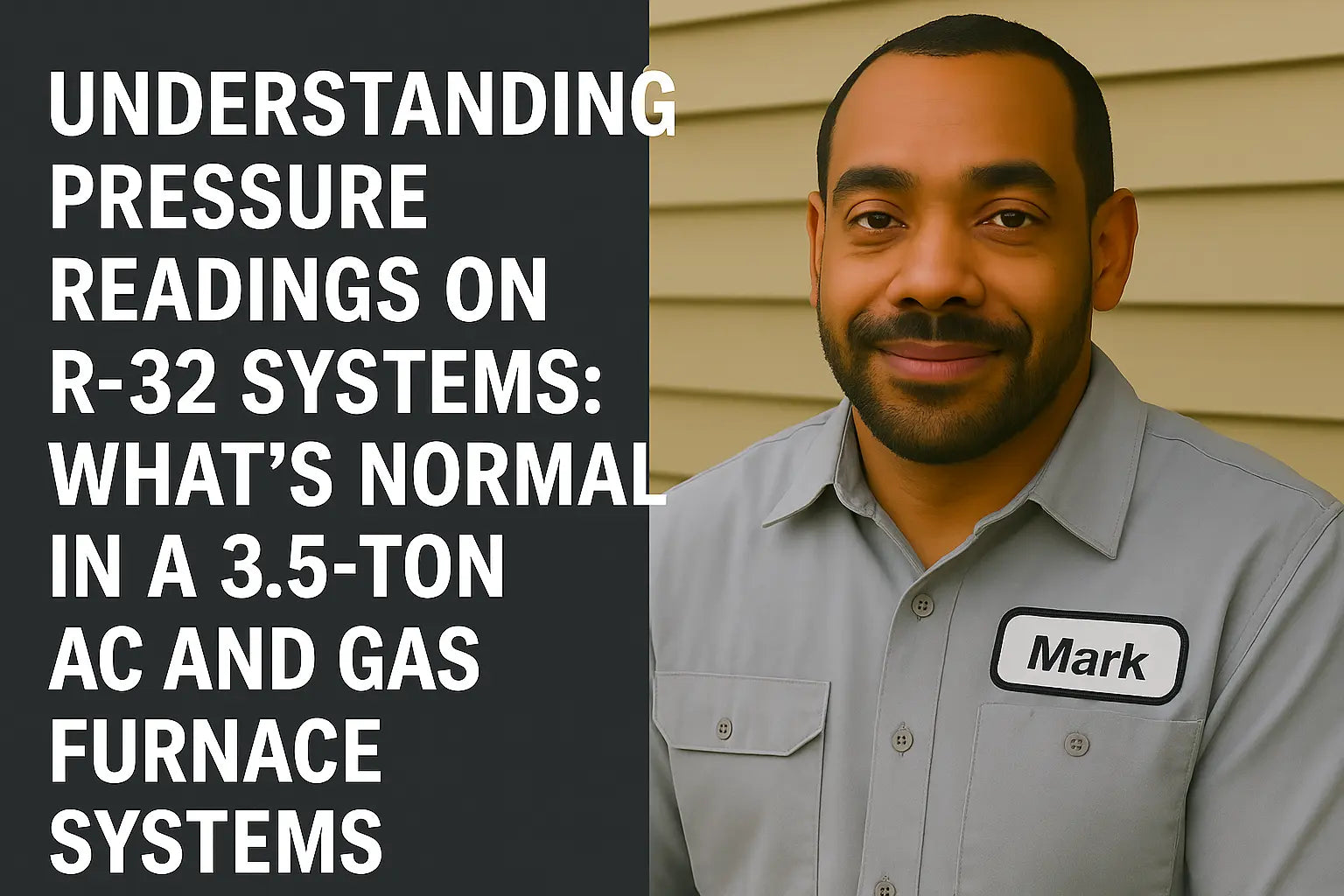Don’t Let the Numbers Freak You Out 😅
If you’re used to R-22 or even R-410A, your first look at R-32 pressures on a 90°F day might make your eye twitch.
“Wait — 150 psi suction and 425 psi head pressure? Is something broken?”
Nope. That’s just how R-32 rolls. It runs hotter, faster, and under more pressure — especially on 3.5-ton systems where refrigerant volume and capacity ride a tighter curve.
So don’t panic — let’s decode what “normal” actually means.
Quick Recap: R-32 Pressure Characteristics 📈
R-32 has higher vapor pressure than R-410A at the same temperature. But since it’s a single-component refrigerant, it behaves more predictably under heat load and ambient swing.
Here’s a quick side-by-side for context (at 95°F ambient):
| Refrigerant | Suction Pressure | Discharge Pressure |
|---|---|---|
| R-410A | ~118–132 psi | ~390–410 psi |
| R-32 | 135–155 psi | 420–450 psi |
💡 Important: These are approximate and depend heavily on line length, airflow, charge level, and indoor load.
For the R-32 PT chart, check out this handy PDF from Hudson Technologies.
What’s “Normal” for a 3.5-Ton R-32 System?
Let’s walk through a typical Goodman or Daikin 3.5-ton R-32 split system setup from The Furnace Outlet, and set expectations for pressure readings during a proper diagnostic.
Ambient Temp: 90°F
Indoor Temp: 75°F
Indoor Wet Bulb: ~63°F
Line Set: 15 ft, 3/8" suction, 3/4" liquid
System Charge: ~7.2–7.8 lbs depending on model
Suction Pressure (Low Side):
140–160 psi
Too low? Suspect:
-
Low airflow (dirty filter, weak blower)
-
Undersized return duct
-
Low refrigerant charge
-
Dirty evaporator coil
Too high? Could mean:
-
Overcharge
-
Low indoor heat load
-
TXV stuck open
Discharge Pressure (High Side):
420–460 psi
Too high? Look for:
-
Overcharge
-
Poor condenser airflow (dirty fins, blocked coil)
-
Oversized system
-
Ambient >100°F with poor ventilation
Too low? You might be looking at:
-
Undersized or restricted metering device
-
TXV underfeeding
-
Low refrigerant charge
You can use tools like the MeasureQuick app to live track pressure, temp, superheat, and subcooling across all zones — especially handy on 3.5-ton setups where refrigerant tolerance is narrow.
Key Readings to Cross-Reference with Pressures
1. Subcooling
💧 Target: 8–12°F (manufacturer dependent)
Subcooling confirms liquid refrigerant is making it to the metering device. Too low? You’re undercharged. Too high? You’re overcharged — or have a restriction.
👉 Always take subcooling off the liquid line at the outdoor unit — don’t guesstimate.
2. Superheat
🔥 Target: 8–15°F (TXV system)
Superheat tells you how much refrigerant is evaporating before it hits the compressor. Low superheat with high suction? You may be flooding the compressor — bad news.
Use wireless probes like Fieldpiece’s JL3PC to track temps accurately in real time.
3. Temperature Split (Delta T)
🌬️ Target: 18–22°F
The difference between return air and supply air. It tells you how much heat the coil is removing from the indoor air.
Too low? Suspect low airflow or low refrigerant.
Too high? You might have a dirty filter or an oversized unit.
Real-World Scenario: Pressure Out of Whack? Here’s What to Check First 🔍
Let’s say you’re on-site with a freshly installed 3.5-ton R-32 system. Ambient is 87°F, and your readings show:
-
Suction: 110 psi
-
Discharge: 475 psi
-
Subcooling: 21°F
-
Superheat: 3°F
🚩 Red flags:
-
Subcooling is too high = likely overcharged
-
Superheat is too low = possible floodback
-
Suction pressure is lower than it should be
🛠️ Fix: Recover refrigerant in 2 oz increments until subcooling drops to 10–12°F. Rerun your readings.
⚠️ Reminder: On R-32 systems, you can’t guess. Even 3–4 oz over can throw off pressures dramatically, especially in tightly charged 3.5-ton systems.
Special Considerations for 3.5-Ton Systems 🧠
-
Line Set Sensitivity: Slight changes in length affect charge more than in 2-ton systems. Always factor line set length into final charge.
-
Oversizing Risks: A 3.5-ton system in a 1500–1600 sq ft home may short cycle if airflow isn’t dialed in.
-
Ventilation Load: Higher internal gains (kitchen near return, sunny rooms) will shift suction pressure upward during mid-day calls.
-
Altitude Effect: At higher elevations, your pressures will drop 0.5–1 psi per 1,000 feet above sea level. Adjust your expectations.
Tools You Need to Read Pressures Right
✅ Digital manifold gauge set (R-32 compatible)
✅ Wireless line temp probes
✅ Smart scale (for charge verification)
✅ Thermometer or temp probes (for return/supply air)
✅ Nitrogen rig (for pressure testing post-repair)
✅ Recovery machine + DOT tank (R-32 compatible only!)
Pro tip: Keep a Refrigerant HQ R-32 PT chart laminated and inside your tool bag. It’ll save your butt in the field.
Avoiding Common Mistakes ❌
-
Charging without a scale
-
Taking suction pressure as gospel without subcooling/superheat
-
Assuming R-32 should match R-410A pressures
-
Forgetting to adjust charge for line set length
-
Not accounting for airflow issues before adding refrigerant
R-32 makes you earn your diagnostics — but the flip side is, when it's dialed in, it's incredibly efficient and predictable.
Final Thoughts: Trust the Numbers, Not the Feel
In R-22 days, we charged by beer-can-cold. With R-410A, we stepped up to subcooling.
Now with R-32 — especially in 3.5-ton systems — it’s all about balance. Your readings aren’t just numbers. They’re the story your system is telling you.
So slow down. Check airflow first. Use the right tools. Cross-reference pressure with temp. And trust your data.
If you're working on one of the new high-efficiency 3.5-ton R-32 systems from The Furnace Outlet, you’re already ahead of the curve. Make sure your gauges and tools are keeping up, too. 🔧📊
Need more installation and troubleshooting tips for your 3.5-ton R-32 systems? Visit my guide right here!
Until next time,
-Mark, your go-to HVAC tech







